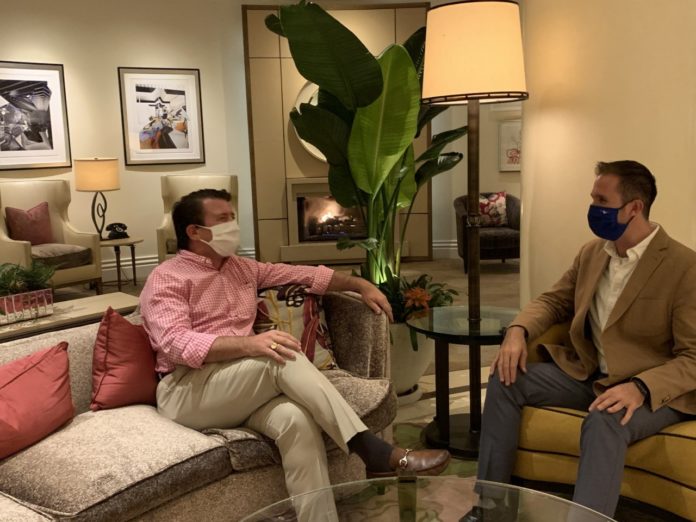CEO Sit-Down Series
In each Cloud 9 issue, Southern Airways & Mokulele Airlines CEO Stan Little will sit down with another industry-leading CEO to discuss business, life, and all topics in between.
There are a lot of perks to being a CEO. One of the best is getting to interact with so many other CEO’s, both in the airline business and in all kinds of other industries. This piece will be the first in a regular series of articles for Cloud 9 where I’ll visit with some of the most interesting business leaders from companies around the corner and around the world.
In advance of his company’s December test flights with Mokulele Airlines, I had the opportunity to sit down with Kevin Noertker, CEO of Ampaire, to talk about the day when we’ll all be flying on electric airplanes. Over drinks and oysters at The Beverly Hills Hotel, plus a follow-up the next day at their Hawthorne, California headquarters, (right next door to SpaceX), I learned that there’s a lot more on the near horizon than most people would suspect.
Stan Little: Kevin, it’s great to see you again. We at Southern and Mokulele are very excited about watching the “Hawaii Bird” take flight in December in Maui.
Kevin Noertker: Great to see you, too, Stan. It’s going to be very gratifying to see our many years of work come to reality. The day we’ve all been waiting for is almost here.
SL: Before we get to the plane and the future, tell us a little about yourself. Where do you live and where did you grow up?
KN: I live in Long Beach, California, not far from our Ampaire headquarters, but I grew up in a little ski town outside Salt Lake, called Park City. Since I grew up, it’s grown into a pretty famous tourist resort!
SL: It seems like a long way from a Utah ski community to building electric airplanes in the heart of Los Angeles. How did your journey get you here?
KN: You know, as I kid, I remember seeming to always be looking up—up at the stars, at the big, puffy clouds, at the crisp blue Utah sky. My childhood was filled with hiking, and camping, and skiing. So, after my education at Caltech and my time working on technology and robotics, I began to wonder, “what can I do to help keep that crisp, clean air that I remember back home? How can I play my part?” That desire ultimately led to Ampaire.
SL: Do you remember when you first “caught the bug” for aviation, as they say?
KN: You know, I started flying very young, so I don’t remember my first flight. But what I do remember is going up in a Cessna 182 with a family friend. He gave me the controls, and I was part excited, part terrified. But I remember very vividly the gorgeous mountain range in front of us. I’m sure that played a role in getting me where I am today.
SL: Do you plan to get behind the controls of the Hawaii Bird next month in Hawaii?
KN: Oh, man, Hawaii– I would love that. I actually got to fly Ampaire’s hybrid plane around the California coast recently, and it was magical. It reminded me of Arthur C. Clark’s third law, “any sufficiently advanced technology is indistinguishable from magic.” With electric, you’re up there in the plane, you push the throttle, and you don’t hear the roar of the engine—you just feel the pull of the propeller.
SL: It’s hard for me to even imagine a near-silent flight experience. People might do that even if they don’t need to go anywhere! Is that what you see for commercial aviation in the future? Where will we be in ten or twenty years?
KN: Oh absolutely. Ten years from now, I see full aircraft fleets using sustainable, hybrid electric motors. The battery technology will likely be there for fully-electric operation of many short-haul flights. In the interim, the series-hybrid—imagine a Prius—fully independent of charging stations but still environmentally friendly will be a reality. Now, jump twenty year ahead, and we’re looking at a significantly different world in 2040. Battery technology will be very advanced, and hydrogen fuel cells may also be prevalent. In the next ten years, you’ll see aircraft up to 19 seats being electrified, but in twenty years, you’re going to see the 35, 50, 75 seat aircraft. Some are even pushing single-aisle [100+ seat types] by then. That’s a heavy lift, but twenty years is a long time in technology evolution.
SL: That’s so exciting. So, looking down the road, does Ampaire plan to be designing motors for larger 50 or 75 seat planes or even Boeing jets?
KN: [laughs] My plan is that they’ll be Ampaire jets! If you look at the companies that were dominant in aviation’s first era, they were the ones who successfully adapted piston-engine technology to their airframes. If you look in the last half century, the jet age, again it’s the companies who adapted the newest and best propulsion systems. It will be the same going forward, and we’re positioning Ampaire to be that company.
SL: Kevin, it’s been such a pleasure. Seeing your operation this week, I have no doubt that Ampaire is a company that is going to be very well-known very soon. We’re so pleased that you selected Mokulele Airlines to be your test partner.
KN: We’re excited, Stan. See you in Maui!







